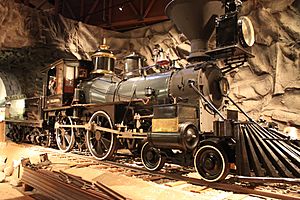Gov. Stanford facts for kids
Quick facts for kids Gov. Stanford |
|
 |
|
| Gov. Stanford, now at California State Railroad Museum | |
| Power type | Steam |
|---|---|
| Builder | Norris Locomotive Works |
| Serial number | 1040 |
| Build date | 1862 |
| Configuration | 4-4-0 |
| Gauge | 5 ft (1,524 mm) (as built) 4 ft 8 1⁄2 in (1,435 mm) standard gauge (as rebuilt) |
| Driver diameter | 54 in (1,372 mm) |
| Weight on drivers | 35,700 lb (16,200 kg) rebuilt |
| Locomotive weight | 50,000 lb (23,000 kg), 56,000 lb (25,000 kg) rebuilt |
| Boiler pressure | 100 psi (690 kPa), 125 psi (860 kPa) rebuilt |
| Cylinder size | 15 in × 22 in (381.0 mm × 558.8 mm) bore × stroke; 16 in × 22 in (406.4 mm × 558.8 mm) bore × stroke rebuilt |
| Tractive effort | 7,791 lbf (34,660 N), 11,081 lbf (49,291 N) rebuilt |
| Official name | Gov. Stanford |
| First run | November 9, 1863 |
| Retired | July 20, 1895 |
| Current owner | Stanford University, loaned to Pacific Coast chapter R&LHS |
| Disposition | static display at the California State Railroad Museum |
The Gov. Stanford is a famous steam locomotive built in 1862. It played a key role in building the First Transcontinental Railroad in North America. This powerful engine was the very first locomotive owned by the Central Pacific Railroad. It was named after Leland Stanford, who was the first president of the railroad and a former governor of California. Today, you can see the Gov. Stanford on display at the California State Railroad Museum.
Contents
The Gov. Stanford Locomotive
The Gov. Stanford is a type of steam locomotive known as a 4-4-0. This means it has four small wheels at the front, four large driving wheels in the middle, and no wheels at the back. It was built by a company called Norris Locomotive Works in 1862.
Journey to California
After it was built, the locomotive was taken apart for its long journey. It traveled by ship, the Herald of the Morning, all the way around Cape Horn. This is the very southern tip of South America. Once it reached California, the parts were loaded onto another boat, the schooner Artful Dodger. It arrived in Sacramento on October 6, 1863.
Starting Work on the Railroad
The Gov. Stanford officially started its work on November 9, 1863. There was a special ceremony with cannons firing to celebrate its arrival. This locomotive was super important for building the First Transcontinental Railroad. It helped connect the eastern and western parts of the United States by rail. The Gov. Stanford was the first engine for the Central Pacific Railroad and was given the number 1.
Early Adventures and Changes
In May 1864, the Gov. Stanford pulled the very first passenger train from Sacramento. This was a big moment for California and the railroad. The locomotive worked hard for many years.
Rebuilding and New Jobs
In 1873, the Gov. Stanford was taken out of its main job of pulling long trains. But its work wasn't over! In 1878, it was rebuilt and made even stronger. It got bigger parts called cylinders and its boiler pressure was increased. This made it more powerful. It also got a special water pump to help put out fires along the tracks.
After its rebuild, the Gov. Stanford worked as a "switcher" in the Sacramento railyard. A switcher locomotive moves train cars around the yard, organizing them for new trains. In 1891, its number was changed to 1174, but some records suggest this new number was never actually painted on the engine.
A New Home at the Museum
The Gov. Stanford retired from service on July 20, 1895. The railroad then gave it to Stanford University. However, it didn't arrive at the university until 1899.
Preserving History
During World War II, the locomotive was taken apart and stored safely. After the war, a retired engineer named Billy Jones put it back together. It was displayed at the university for many years.
In the 1960s, Stanford University needed the space where the engine was displayed. So, in 1963, the Gov. Stanford was loaned to the Railway & Locomotive Historical Society. This group was collecting old trains to create a museum.
Display at the Museum
Eventually, these historic trains became part of the California State Railroad Museum in Sacramento. The Gov. Stanford is now a main attraction at the museum. It has been carefully restored to look just like it did in 1899. It helps visitors learn about the amazing history of railroads in America.

